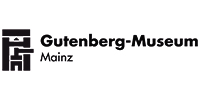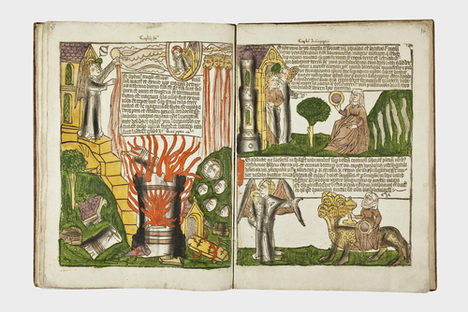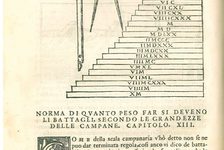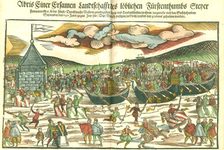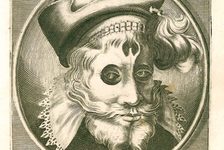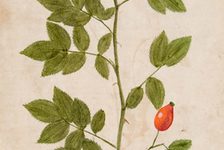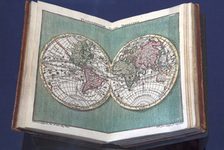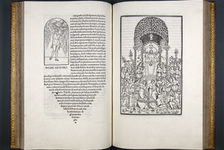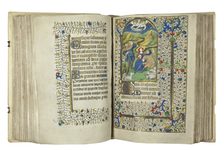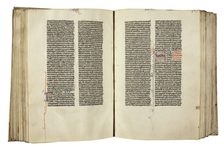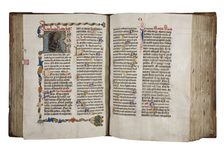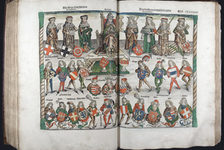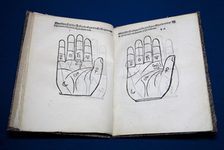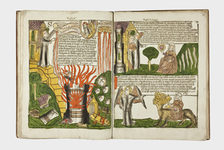Book History
The Gutenberg Museum owns a unique collection of materials on book history that covers seven centuries and ten thousand volumes. The museum's holdings, which are examined and collected at the Gutenberg library and in part included in the museum exhibitions, impressively document the development of the book as a medium.
More than seven hundred years of book history
The collection includes books from the 15th to the 21st century. It is centered on the two copies of the 42-line Gutenberg Bible of 1452-55, complemented by more than 3,300 of the world's most exclusive incunabula.
Other collection areas pay tribute to the multitude of forms that the printed book has taken on in the course of its history. These include fine press prints, artists' books, picture and children's books, plus an extensive collection of miniature books.
Incunabula
The collection includes around 3,300 early prints (incunabula stems from Latin for "swaddling clothes", or "cradle"). Next to the two Gutenberg Bibles, the collection also includes copies of the world-famous "World Chronicle" by Hartmann Schedel (1493) and the "Cosmographia" (1482), a printed Atlas based on the work of Ptolemy, which is considered a milestone of cartography.
One of the 15th century's most beautiful works is also included in the collection. Francesco Colonna's "Hypnerotomachia Poliphili" (Poliphilo's Strife of Love in a Dream ) of 1492 with woodcutting in the Italian Renaissance style is considered to be a masterprice of early letterpress printing.
Books from the 16th to the 18th century
The collections of the 16th to the 18th century trace the diversity and the development of books regarding their topics and relevance to media history.
The highlights of the collection include Sebastian Brandt's "The ship of fools" (1506) with woodcuttings that were presumably created by the young Albrecht Dürer and the romantic knights' tale "Theuerdank" (1517) with which the young Emperor Maximilian created a monument for himself.
The collection also includes important scientific works, such as the "Astronomicum Caesareum“, an astronomical book for Emperor Karl V., which Peter Apian printed 1540 in Ingolstadt.
Books from the 19th to the 21st century
The collection on the book history of the 19th to the 21st century feature the conflict between industrial mass production and artistically demanding book publications that were often printed by small presses and limited press runs.
Among others, key exhibits were created by famous typeface artists of the Art Nouveau such as Otto Eckmann and Rudolf Koch, and illustrators including Marcus Behmer and Thomas Theodor Hein.
Typeface samples and typeface sample books of the most prominent type foundries and the key type artists vividly present evolution of typography.
Fine press prints
Around 2,500 fine press prints of the late 19th to 21st century form part of the Gutenberg Museum's collection. The books that are elaborately crafted with artistic artisan techniques form a deliberately contrast to the mass commodity "book" that emerged in the early 20th century due to technical (print) developments.
Fine press prints are usually distinguished by their artistic design. Each step of book production– from the selection of the typeface, via typesetting, printing, and illustration, is given special attention, turning the book into an "overall work of art."
Picture books and children's books
The holdings of the museum also include children's books from the 18th to the 20th century. Important works include the "Bilderbuch für Kinder“ published by Friedrich Justin Bertuchs from 1790, and Heinrich Hoffmann's "Struwwelpeter" (1844).
The collection also includes picture books by famous illustrators of the 19th and 20th century such as Kate Greenaway, Arthur Rackham, Ernst Kreidolf, Lieselotte Schwarz, and Maurice Sendak.
Miniature books
Miniature books denote books whose block is no larger than 10x10 cm. After purchasing the Heinz Müller collection in 2012, the Gutenberg Museum now owns Europe's largest miniature book collection containing around 6,900 books. The collection ranges from fine literature via dictionaries and cook books up to calendars and offers a unique insight into world of the tiniest books.
Artist books
Grappling with the role of books in modernity animates many artists to design books as objects that often distort or negate reading.
The collection of artist books of the Gutenberg-Museums includes works by Karlheinz Zwick, Julia Farrer, Anton Würth, and Barbara Beisinghoff.
